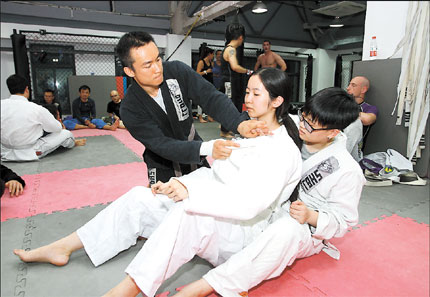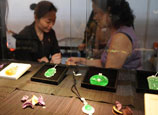
 |
| Stanley Tam (in black) instructs combating skills to a pair of Brazilian Jiujitsu trainees.(Photo/Shanghai Daily) |
Brazilian jiu-jitsu is not as well known as other martial arts, but a small and growing group of devotees in Shanghai say it is great for self-defense, training the mind and keeping fit. Nie Xin gets on the mat and grapples with the sport.
Some people live with passion and are not just interested in how to make more money. Some have a passion for martial arts and sports, and some are making efforts to bring more energy to this world.
On a hot summer night at a sports studio on Jumen Road, near the Bridge 8 creative park, more than 30 people - half international and half local, and a mix of males and females - gather. They are wearing thick martial arts uniforms.
After some warm-up exercises like sit-ups and push-ups, a coach demonstrates some basic defense moves to the trainees. He teaches mostly in English, but also explains some skills in Mandarin so Chinese trainees understand clearly. All of them are sweating. They are learning Brazilian jiu-jitsu from coach Stanley Tam, a Hong Kong-born Australian who founded Shanghai Brazilian Jiu-jitsu (SHBJJ) nine years ago. Now SHBJJ has several branches in town and around 120 students.
Brazilian Carlos Gracie and Helio Gracie adapted kodokan judo ground fighting, passed their knowledge onto their family members and formed BJJ, which promotes the concept that a smaller, weaker person can successfully defend himself or herself against a bigger, stronger assailant by using leverage and proper technique, taking the fight to the ground.
Three years ago, Tam gave up his job as a financial manger and became a full-time BJJ coach.
"The most important thing to do this is 'passion'," Tam says, "BJJ is a very attractive sport - how to react to your opponent with strategy in fighting. It is an exercise both physically and mentally."
Regarded as the world's newest martial art, BJJ is a grappling art, combat sport, and a self-defense system that focuses on grappling and especially ground fighting. BJJ has very complex moves which makes it more of a mind sport. It's not just a bunch of meatheads beating each other up, but is more akin to a life-size game of chess, according to Tam.
Tam recalls immigrating to Adelaide, Australia, at the age of seven with his family in the 1980s.
"There were not many Chinese there at the time, and I have loved Chinese martial arts since very young," Tam says.
To learn authentic Chinese martial arts, Tam has been to Singapore and China's Taiwan, and he initially learned internal martial arts, as well as boxing and kick-boxing.
Tam says he came to Shanghai in 2001 to learn Chinese martial arts and surprisingly contacted BJJ.
"I had known about BJJ very early, but never had a chance to learn it," Tam says.
Tam says he met some other expatriates who did BJJ, and he started training with a British man in 2004.
"BJJ initially got popular in Brazil and California about 10 years ago; in recent years, Chinese people have started to catch on to this charming sport. Our group only had about 10 people at the beginning, but today the club attracts more and more people," Tam says.
There are now around 120 regular members in SHBJJ. They include lawyers, doctors, students, males and females, adults and children. Eight instructors provide classes. The team is international, including Chinese, British and American.
"The most senior student here has been learning for over six years. This sport is very charming as you need to use both mental and physical strength," says Chen Yi, co-founder of SHBJJ.
Chen, a former boxer, says he started BJJ three years ago after meeting Tam.
"For beginners, it generally takes four months," Chen says. The basic course is 16 weeks to complete basic training. Three times a week is required. A one-hour class costs 150 yuan (US$25) although discounts are available for an entire course.
The organizers insist that strict safeguards are in place to prevent serious injuries during fights, while a well-trained instructor referees each match and awards points depending on individual style.
Jiu-jitsu is one of the best self-defense martial arts. People come to the academy for different purposes but physical fitness is an added bonus.
"There is no limitations on age, gender, occupations," Tam says. "BJJ is more than a martial art, it is a jiu-jitsu lifestyle - natural, healthy, confident, and of course wise."
Tam says he watches his diet - eating light and more organic food so he has more energy for BJJ.
"I know that I need to keep fit to have more energy to compete in this sport. BJJ is not merely a fight for us - it makes us pursue a healthier lifestyle, which is good for the mind and improving you memory," Tam adds.
Tam says he likes sports and activities that are closer to nature, such as hiking and swimming.
The instructor says he has noticed how people in Shanghai have become more interested in sports and exercise in the past five years or so.
"When I started to learn BJJ here, few local Chinese knew about it and most members were expats," Tam says. "But now there are more local people interested in this sport, even females."
The ratio of female members has risen from the initial 1 percent to 10 percent, he adds.
Website: www.shanghaibjj.com
Belt color stands for different levels
12 to 18 months: white to blue
Another 2-3 years: blue to purple
Another 2-3 years: purple to brown
Another 2-3 years: brown to black
















 Rainstorms flood more than 10,000 cars in underground garages in Wuhan
Rainstorms flood more than 10,000 cars in underground garages in Wuhan


![]()
